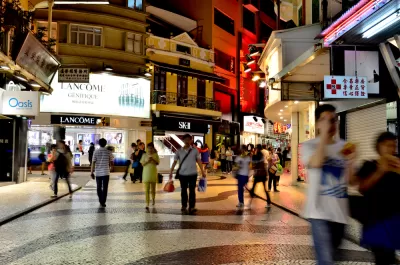Reid Ewing and Amir Hajrasouliha guest blog about their new article investigating the impact of street micro environments on pedestrian activity.

Guest Bloggers Reid Ewing and Amir Hajrasouliha
The experience of walking down a given street may have a lot to do with the micro environment of the street itself. Urban designers presume that streetscape features are important for active street life, but have little empirical evidence to back the claim. We investigated this relationship in an article in the Journal of Planning Education and Research (JPER) (Free Link until 8/31/2015).

By measuring 20 streetscape features and numerous other variables for 588 blocks in New York City, we were able to identify variables that explain pedestrian traffic volumes. We found significant positive correlations between three out of 20 streetscape features with pedestrian counts after controlling for density and other built environmental variables. The significant streetscape features are the number of pieces of street furniture, the proportion of windows on the street, and the proportion of active street frontage.
What are the implications for planning practice? First, context is important, particularly floor area ratio (FAR) and population density, within a quarter mile of commercial streets. Zoning can be amended to achieve high values of each of these variables. Accessibility to rail transit can have positive impact on street life. In addition, streets themselves should have high FARs and predominantly retail frontage.
From the perspective of urban design practice, it is important to know which streetscape features have significant relationship to pedestrian activity and how to operationalize these features. The first feature is street furniture, defined as all kinds of signs, benches, parking meters, trash cans, newspaper boxes, bollards, street lights, and so forth, anything at human scale that increases the complexity of the street. Providing urban furniture and specifically urban seating is a common recommendation for activating public spaces. Our study, verified the power of this recommendation. However, it is important to note that this recommendation can also cause a not so rare practical error among urban designers. The perception that installing urban furniture guarantees or increases pedestrian activities without taking into account all other important factors, such as land use, public safety, or other design elements is just simply not accurate.

The second feature is "windows as a percentage of ground floor façade," which is a common operational definition of transparency. Street vitality highly depends on its interaction with adjacent buildings; and high level of transparency at the ground level can facilitate this interaction. The last feature is the percentage of active uses, defined as shops, restaurants, public parks, and other uses that generate significant pedestrian traffic. Inactive uses include blank walls, driveways, parking lots, vacant lots, abandoned buildings, and offices with no apparent activity. In regard to residential uses, when the density is more than 10 units per acre, we assume that the land use is active. A lesson from this finding is to monitor land use changes at street level before investing in streetscape projects. For example, a corridor that is losing its commercial identity to non-active uses may not be a preliminary priority for becoming a pedestrian-dominated street.
Blog post by Reid Ewing (Director of the Metropolitan Research Center, University of Utah) and Amir Hajrasouliha (University of Utah). Other authors include, Kathryn Neekerman, Columbia University, Marine Purciel-HIlle, Human Impact Partners, and Bill Greene, NYU Stern.
Open Access Until August 31, 2015

Manufactured Crisis: Losing the Nation’s Largest Source of Unsubsidized Affordable Housing
Manufactured housing communities have long been an affordable housing option for millions of people living in the U.S., but that affordability is disappearing rapidly. How did we get here?

Americans May Be Stuck — But Why?
Americans are moving a lot less than they once did, and that is a problem. While Yoni Applebaum, in his highly-publicized article Stuck, gets the reasons badly wrong, it's still important to ask: why are we moving so much less than before?

Research Shows More Roads = More Driving
A national study shows, once again, that increasing road supply induces additional vehicle travel, particularly over the long run.

Concrete to Community: A Schoolyard Makeover in West Philly
With guidance from the Trust for Public Land, third graders at Overbrook Elementary are leading the redesign of their asphalt schoolyard into a vibrant green space, learning valuable skills and creating lasting community impact in the process.

Which US Rail Agencies Are Buying Zero-Emissions Trains?
U.S. rail agencies are slowly making the shift to zero-emissions trains, which can travel longer distances without refueling and reduce air pollution.

San Diego School District Approves Affordable Housing Plan
The district plans to build workforce housing for 10 percent of its employees in the next decade and explore other ways to contribute to housing development.
Urban Design for Planners 1: Software Tools
This six-course series explores essential urban design concepts using open source software and equips planners with the tools they need to participate fully in the urban design process.
Planning for Universal Design
Learn the tools for implementing Universal Design in planning regulations.
City of Moreno Valley
Institute for Housing and Urban Development Studies (IHS)
City of Grandview
Harvard GSD Executive Education
NYU Wagner Graduate School of Public Service
City of Cambridge, Maryland
Newport County Development Council: Connect Greater Newport



























